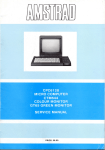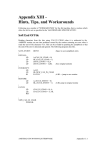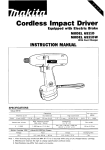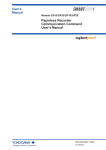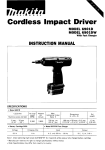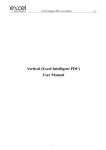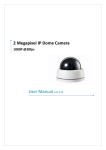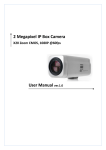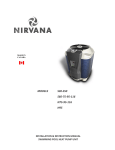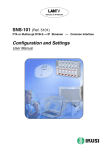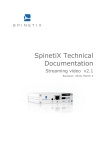Download NIRVANA
Transcript
NIRVANA To load NIRVANA type RUN"DISC or RUN"NIRVANA The main menu offers seven options: (1) NIRVANA Select Nirvana and after a short delay the opening screen will appear. A scrolling message requests that you insert your source disc into drive A. Remove Nirvana from the drive and insert your source* disc then press any key. *The source disc is the disc which you wish to back-up, copy files from, format etc. Nirvana's working screen now appears and is divided into two sections: (1) The upper section displays information concerning the files on the source disc. The first line of the lower section shows: (a) The number of Kbytes free disc space (b) How many files selected together with their size (c) The disc format (d) Present source and destination drive selection The remainder of the lower section shows the commands available within Nirvana. Upper Section - file information Information about each file on the source disc is displayed in four columns. Each column contains the following information about each file: USER NUMBER FILENAME & READ/WRITE “S” IF EXTENSION STATUS SYSTEM Example: 10 NIRVANA BIN * S In this example the file is: USER 10 NIRVANA.BIN READ ONLY SYSTEM Lower Section - command keys The commands are selected using a single keypress are are as follows: CURSOR KEYS... Move cursor R... Rename a file COPY KEY.....Select/deselect a file D... Copy a disc C....Copy a file A....File attributes F...Format a disc E...Erase a file L...Log in a disc S...Select a drive ESC..... Exit Nirvana Cursor Keys Use the cursor keys to highlight the file(s). Copy key Use the copy key to select or deselect files Please Note Files must first be selected before any, attempt is Copy, Erase, Rename or Change file attributes. Copy a File Source and destinations drives together with files to he copied must be selected before choosing this Whilst file copying, Nirvana will make use of the rear bank on the 6128 or any additional (DK'tronics) memory on all three CPC's (up to 256K). This option gives full on-screen reporting of how file transfer is progressing. Copy a Disc Use this option to copy individual tracks or back-up your own discs. As Nirvana is capable of backingup some commercial discs it is vital that the user is aware that : IT IS AN OFFENCE UNDER THE 1988 PATENTS, DESIGN & COPYRIGHT ACT TO MAKE COPIES OF COMMERCIAL SOFTWARE (EVEN FOR YOUR OWN USE). AUTHORITY SHOULD FIRST BE OBTAINED FROM THE COPYRIGHT HOLDER BEFORE ATTEMPTING TO MAKE A BACK-UP COPY. Source and destination drives should first be selected. This option also gjves full on-screen reporting of how disc copying is progressing. Format Both Data and Vendor(system) formats are catered for. Care should be taken when using this option because formatting will erase any files present on the disc. Ensure the write-protect tab is closed. Once either data or vendor format has been selected you are requested to insert the disc in the appropriate drive. Adequate opportunity is given to escape from this option should you so desire. Log in a Disc Used to change the source disc. Erase a file Both single and multiple erasure of files is possible. Files should first be selected. Rename a File Both single and multiple renaming of files is possible. Files should first be selected. File Attributes Four options are available. Single or multiple files should be selected before using any of these options: 1) RW/DIR - file is both Read and Write and can be erased. It is a Directory file and can be catalogued. 2) RW/SYS - file is both Read and Write and can be erased. It is a System file and cannot be catalogued. 3) RO/DIR - file is Read Only and cannot be erased. It is a Directory file and can be catalogued. 4) RO/SYS - file is Read Only and cannot he erased. It is a System file and cannot be catalogued. Select Drives This option allows any disc drive combination to be selected . It will also read and write to 3.5" and 5.25" drives running under AMSDOS. Directory Editor After selecting the appropriate drive the discs'sdirectory will be read and displayed on screen. There are twelve options listed at the foot of the screen and all are self explanatory. Disc Map After selecting the appropriate drive the whole disc will be mapped. The resultant map can be shown on screen or sent to your printer. The map shows the name of the file, its type together with the tracks and sectors it occupies. This option is best used prior to searching through a disc using the sector editor as it shows what tracks/sectorsd any particular file can be found on. Sector Editor After selecting the appropiate drive you are requested to enter a track number followed by a sector number. The first 256 bytes of the selected sector will then be displayed in both HEX and ASCII. Use the cursor keys to move and the numeric keypad for the other options.The copy, key will write the modified track and sector information back to disc. Data Format Sector Map can be found at the rear of this instruction book and has been included to help guide you round a data formatted disc. The directory track on a data format disc starts at track 0 sector C1. Every file on disc will be written to track(s) and sector(s). These are listed as BLOCK numbers in the row immediately.under the filename and are in ascending, but not necessarily sequential, alpha-numeric order. With very long files the sixteen bytes allocated for one entry may not be sufficient and there will be a second or subsequent entry followed by a further row of block numbers. Catalogue Example 00 58 31 20 20 20 20 20 20 41 53 43 00 00 00 10 OX1 0000ASC0000 02 B1 00 00 00 00 00 00 00 00 00 00 00 00 00 00 0000000000000000 00 4E 31 20 20 20 20 20 20 42 49 4E 00 FF 00 2E ON10000BIN0000 03 04 05 06 07 08 00 00 00 00 00 00 00 00 00 00 0000000000000000 In this example the file Xl.ASC is stored at block numbers 02 and B1. Block 02 equates to track 0 sectors C5 and C6 and block B1 equates to track 39 sectors C4 and C5. This is unusual and indicates that the disc is, or has been, at maximum capacity. Archive/Restore a Disc This option is very much akin to "Tape Streamers" on PC machines used to "back-up" the machines hard disc. It will automatically save to a cassette tape, in Data format, the entire contents of a disc extremely,quickly. A data formatted disc will archive in about 15 minutes without any attention from the operator. Restoration of a previously archived tape will also take about 15 minutes. Also included is the option to write a header (of up to 80 characters) at the beginning of the tape. This enables an archived tape to be easily identified at a later date. A verify option is included allowing archived material to be checked against the original. It can be used to back-up important discs so that, should the program be lost, the disc can be re-written from the archived tape. It can also be used to archive seldom used programs which my be needed at some future date thus allowing recovery of valuable disc space. To archive a disc follow the prompts. All information on the disc will be transferred to tape in 8 track sections. Should you have several files/programs on different discs you can archive them as follows: Format a disc to Data format and proceed to transfer all the required programsifiles to this disc. Once the disc is complete select the archive option and follow the prompts. To verify the tape rewind it and select the verify option and follow the prompts. When using the restore option the program will show what format the original disc was. The receiving disc must be the same format. File Archive This option is similar in operation to Disc Archive but differs in its method. It archives any files on disc by name and in alpha-numeric order. Any number of files can be archived as follows: Format a disc as Data format and proceed to transfer all the required files to this disc. When all files are present select this option and follow the prompts. No further attention is required by the operator. As with Disc Archive it uses are to back-up important or seldom used programs so that, should any program be lost, the program can be recovered from the archive tape. Verification of archived material can be confirmed by CATaloguing the tape ensuring the blocks of each file check out Ok. File Restore is used to restore files from tape which have been archived with the above option. We recommend the use of a freshly formatted Data disc for restoring archived files. Having selected this option you are prompted to enter the number of files to restore. If you do not know how many files onthe tape then enter "0" (zero). You are then asked if you wish to restore Automatically or Manually. Normally you would select "A" for automatic which will restore all files on tape using their original filenames. However, if you only wish to restore some of the files or should You require to rename any file during the restore operation then use "M" for manual mode. As each file is retrieved from tape the program will wait for you to enter a save name. Pressing the enter key will restore the file under its original name. If you do not wish be retore a file pressing the CLR will cause the program to skip to the next file. Full information on each file is given as it is restored can he echoed to your printer by pressing the Copy key. DATA FORMAT SECTOR MAP T R A C K C1 C2 C3 C4 C5 C6 C7 C8 C9 00 01 02 03 04 05 06 07 08 09 10 11 12 13 14 15 16 17 18 19 20 21 22 23 24 25 26 27 28 29 30 31 32 33 34 35 36 37 38 39 00 04 09 0D 12 16 1B 1F 24 28 2D 31 36 3A 3F 43 48 4C 51 55 5A 5E 63 67 6C 70 75 79 7E 82 87 8B 90 94 99 9D A2 A6 AB AF 00 05 09 0E 12 17 1B 20 24 29 2D 32 36 3B 3F 44 48 4D 51 56 5A 5F 63 68 6C 71 75 7A 7E 83 87 8C 90 95 99 9E A2 A7 AB B0 01 05 0A 0E 13 17 1C 20 25 29 2E 32 37 3B 40 44 49 4D 52 56 5B 5F 64 68 6D 71 76 7A 7F 83 88 8C 91 95 9A 9E A3 A7 AC B0 01 06 0A 0F 13 18 1C 21 25 2A 2E 33 37 3C 40 45 49 4E 52 57 5B 60 64 69 6D 72 76 7B 7F 84 88 8D 91 96 9A 9F A3 A8 AC B1 02 06 0B 0F 14 18 1D 21 26 2A 2F 33 38 3C 41 45 4A 4E 53 57 5C 60 65 69 6E 72 77 7B 80 84 89 8D 92 96 9B 9F A4 A8 AD B1 02 07 0B 10 14 19 1D 22 26 2B 2F 34 38 3D 41 46 4A 4F 53 58 5C 61 65 6A 6E 73 77 7C 80 85 89 8E 92 97 9B A0 A4 A9 AD B2 03 07 0C 10 15 19 1E 22 27 2B 30 34 39 3D 42 46 4B 4F 54 58 5D 61 66 6A 6F 73 78 7C 81 85 8A 8E 93 97 9C A0 A5 A9 AE B2 03 08 0C 11 15 1A 1E 23 27 2C 30 35 39 3E 42 47 4B 50 54 59 5D 62 66 6B 6F 74 78 7D 81 86 8A 8F 93 98 9C A1 A5 AA AE B3 04 08 0D 11 16 1A 1F 23 28 2C 31 35 3A 3E 43 47 4C 50 55 59 5E 62 67 6B 70 74 79 7D 82 86 8B 8F 94 98 9D A1 A6 AA AF B3 SECTOR








